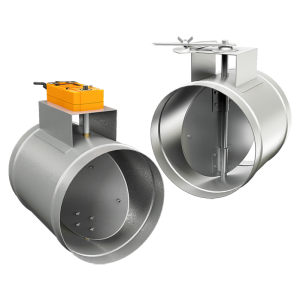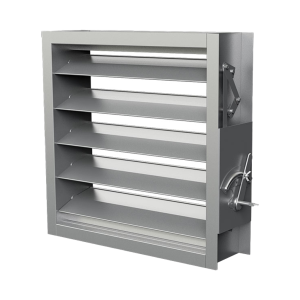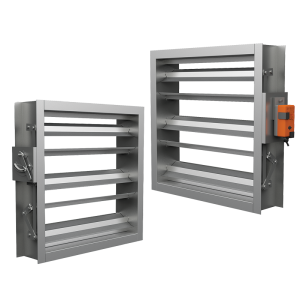
3D
The motorized duct damper is used to control the air flow rate in the ducts and air distribution valves, and its function in the ducts is exactly the same as the faucet in the water supply pipelines. For this purpose, it is used both for connecting and disconnecting and for controlling the amount of current. This action is done by embedded vanes (in this model it is V-shaped). This air flow control becomes important when there is a need for aeration in one area or in one season of the year, as well as to control the speed and adjust the proper aeration in different branches of the channel.
Channel dampers, which are one of the types of air conduction dampers, are a means to stop or adjust the air flow in the channels. The damper may be placed on the main line of the air channel, or it may be placed on any sub-line of the room to the room of the channel damper to block the air entering the room that is unused or to adjust the air entering (hot or cold air) to each room. . Channel dampers are adjusted in two ways, manual and automatic. Manual dampers are adjusted by the damper handle that is installed on the outer space of the damper, while automatic dampers are controlled by an electric or pneumatic motor that is installed on the damper shaft in the outer space of the damper. Motorized automatic dampers are controlled by thermostat, potentiometer or central building automation system. Three types of motor dampers are recommended for use in motorized dampers:
Three-state motor: when the power is connected, the motor starts to move (open or closed) and as soon as the power is cut off, the motor and consequently the damper vanes remain in the same position.
Stepper motor: These types of motors receive 0 to 10 volts and open 0 to 100 according to it. The easiest way to use this type of motor dampers is to use a potentiometer for 0 to 10 volts input.
Return spring motors: These types of motors work as fully open or fully closed. The spring in the motor is collected when the damper is opened, and in case of power failure, it closes the damper (normally close). This action can also be the opposite, i.e. the spring inside the damper is retracted when it is closed and helps to open the damper in case of power failure (normally open).
Motorized dampers, like manual dampers, can be supplied in two types, round and square. Also, this type of dampers can be supplied with a single-layer V-shaped blade or a double-layer blade with an airfoil geometry. For better air sealing, if required by the customer, a steel air sealing strip is used on the connecting point of the blade shaft to the frame. It is also possible to add a silicone rubber air sealing strip on the edge of the vane to minimize air leakage when the damper is fully closed. Dampers of motorized channels can be produced in two forms: counter vanes for more control over the flow rate and parallel vanes to cut off the air flow more quickly.
Construction of motorized damper
Motor channel dampers can be made as single or multiple blades, the blades can be opened or closed up to 90 degrees phase difference with the help of a lever made of PVC or iron. As a result of this change in the angle of the blades in the air path of the channel; The flow passage is blocked or reversed and as a result the flow is controlled. In motorized dampers, the vanes rotate two by two in opposite directions when opening and closing, and for this reason, it is called a reciprocal damper.



